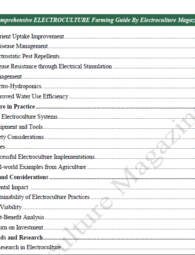Welcome to Electroculture Magazine! In this article, we will discuss how to electrify water for plants in Electroculture . Electrolysis releases oxygen into the water, which is an important nutrient for plants. It also makes the water more alkaline, which can help to improve plant health and productivity. We hope you enjoy this blog and find it helpful. If you have any questions or comments, please feel free to contact us.
Introduction

Electrifying water for plants in electroculture involves applying a low-frequency, low-voltage electric field to water in the vicinity of plant roots. The electric field stimulates the plant roots and promotes better nutrient uptake and water retention. Here’s how to electrify water for plants in electroculture:
Steps : How to Electrify Water for Plants in Electroculture?
- Determine the type of electric field to use : Electroculture can make use of both AC (alternating current) and DC (direct current) electric fields, among other forms of electric fields. Since AC fields are simpler to produce, maintain, and are less likely to harm plant roots, they are more frequently used.
- Choose the appropriate equipment : You will need a power source, an electrode, and a water reservoir to electrify water for plants. The electrode should be constructed of a conductive substance that can be submerged in the water reservoir, and the power source should be capable of producing a low-frequency, low-voltage electric field. The water reservoir should be big enough to hold the water the plants require.
- Set up the equipment : Connect the power source to the electrode and place the electrode in the water reservoir. Make sure that the electrode is submerged in the water and is not in contact with any of the plant roots. Connect the power source to a timer or controller that can regulate the electric field.
- Determine the appropriate electric field strength and duration : The type of plant, the soil, and other environmental conditions will affect the electric field’s intensity and duration. To prevent harming the plants, it is crucial to start with a weak electric field strength and progressively raise it over time.
- Apply the electric field : Once you have determined the appropriate electric field strength and duration, turn on the power source and apply the electric field to the water. The electric field should be applied for a specific duration each day or week, depending on the plant’s growth stage and other environmental factors.
- Monitor the plant growth : To make sure that the electric field is not harming the plants, it is crucial to regularly check on their growth. Watch for wilting, color changes, or other indications of stress. Adjust the electric field’s intensity or duration if you see any signs of stress.

Here are some additional tips for using electroculture to improve plant growth:
- Use fresh water. Electrolysis can release chlorine and other harmful chemicals from tap water.
- Use a clean container. Any dirt or debris in the container can interfere with the flow of electricity.
- Place the electrodes in the water correctly. The positive electrode should be placed in the center of the container, and the negative electrode should be placed on the opposite side of the container.
- Use the correct amount of electricity. The amount of electricity needed will vary depending on the size of the container and the number of plants being watered.
- Monitor your plants closely. If you notice any signs of stress, such as wilting or yellowing leaves, reduce the amount of electricity being used.
With a little care and attention, you can use electroculture to improve the health and productivity of your plants.
Final Words
In conclusion, electroculture involves the application of an electric field to water near plant roots that is low-frequency and low-voltage. The plant roots are stimulated by the electric field, which also encourages improved nutrient absorption and water retention. It is crucial to get the right equipment, set it up correctly, choose the right electric field strength and duration, apply the electric field, and regularly check on plant growth.
Get more accurate guidance from ELECTROCTURE TEXTBOOKS, choose your book by clicking below...







![Electroculture Bible: [7 IN 1] by Rick Croppield Electroculture Bible: [7 IN 1] by Rick Croppield](https://electroculturemagazine.com/wp-content/uploads/2023/08/B0C47Q56RC.01._SCLZZZZZZZ_SX500_-200x290.jpg)

![Electroculture Bible: [5 IN 1]: by Benjamin Foster Electroculture Bible: [5 IN 1]: by Benjamin Foster](https://electroculturemagazine.com/wp-content/uploads/2023/08/51XVYHHWHfL._SX384_BO1204203200_-200x290.jpg)

